Europe Wireless Sensors Market Size
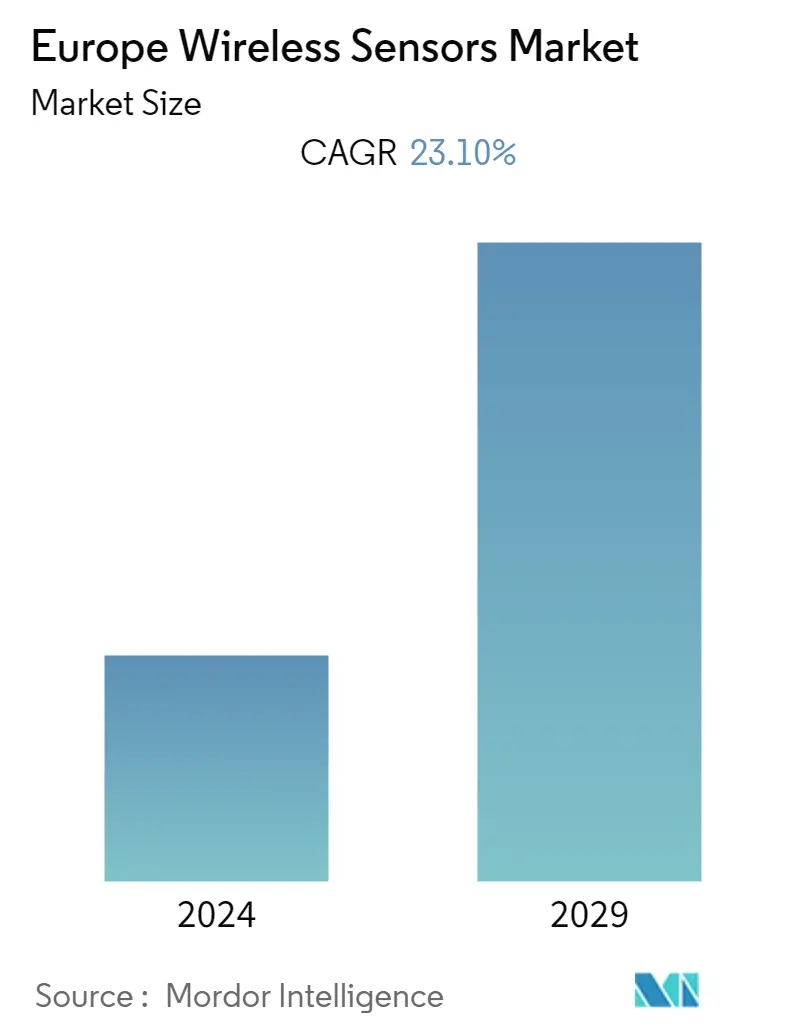
| Study Period | 2019 - 2029 |
| Base Year For Estimation | 2023 |
| Forecast Data Period | 2024 - 2029 |
| Historical Data Period | 2019 - 2022 |
| CAGR | 23.10 % |
| Market Concentration | Medium |
Major Players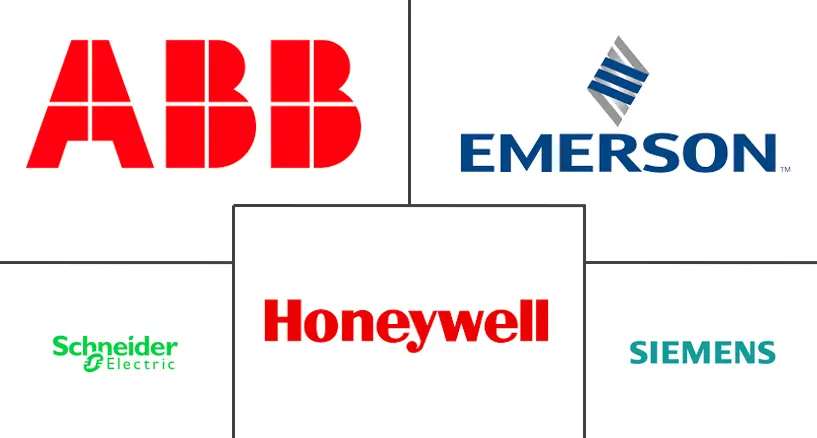
*Disclaimer: Major Players sorted in no particular order |
Europe Wireless Sensors Market Analysis
The European wireless sensor market is expected to register a CAGR of 23.1% during the forecast period (2021 - 2026). The growth in Industry 4.0 with the COVID-19 pandemic on the global scale has been acting as a catalyst that pushed the development of intelligent wireless sensors that help improve energy consumption with a high level of efficiency in the region. The growing range of pressure applications in industries contributes to developing single devices that can handle a range of pressures. Such devices are developed to simplify product designs, accelerate time to market and reduce sensory inventory costs of industrial manufacturers.
- The growth of the wireless sensors market is driven by the application in the various end-user industries. Manufacturers invest in R&D activities to improve the accuracy and reliability of wireless sensors. Wireless sensors are used for data monitoring and other similar functions and in building automation, military and defense, and other industries, like food and beverage and material handling.
- The key drivers influencing the wireless sensors market are the increasing need for new renewable energy development, energy sources, and other rapid technological advancements in the United Kingdom. They are also a vital component in smart grids for remote monitoring of transformers and power lines where they are put into service to monitor line temperature and weather conditions.
- Europe, which houses most automotive manufacturers, is expected to retain a substantial share in the market. The abundant availability of raw materials and the low establishment and labor costs have helped companies establish their manufacturing operations in the Asia-Pacific. It is expected that the vendors, to create an advantage of the first mover in technology transitioning, may adopt this evolution and invest in R&D according to their strategic vision.
- Many retailers and grocery stores are using wireless sensors on the floor to help employees create positive experiences for customers. Wireless push sensors can help the shoppers to indicate when cleaning is needed. Wireless air temperature devices are also assisting the superstores in monitoring refrigerators and non-cold merchandise simultaneously.
- Further, the energy and power sector has created an essential demand for wireless sensors in industrial applications. As energy conservation is increasingly important to reduce power consumption and its associated costs, accurate wireless sensors are required with appropriate wireless technologies helpful for testing devices for diesel truck emissions, wind engineering, wind energy systems, concerning new building design aerodynamics, ocean research, high-altitude weather research balloons, water pollution devices, smokestack mercury sampling, and atmospheric studies.
Europe Wireless Sensors Market Trends
This section covers the major market trends shaping the Europe Wireless Sensors Market according to our research experts:
Automotive is Expected to Hold Significant Market Share
- Automotive vehicles have undergone various changes over the last few decades. Previously, cars used to work with basic electrical systems that offered power for headlights and spark plugs. As technology progressed, cars were fitted with the latest gadgets, such as radios, alarms, and wipers. Various technological advancements have also been made for vehicles’ safety, such as airbag deployment. The increase in these sensor-dependent features has driven engineers to develop more accurate sensors with automotive applications in mind.
- Currently, the two significant trends for the automotive sector are electrification and automation. The emergence of electric vehicles in the industry has dramatically impacted the demand for wireless sensors in the long term. More electric cars mean an increase in demand for sensors, a surge in sensors for used battery monitoring, and various positioning and detection of moving parts of automobiles.
- Moreover, with the increasing use of electric vehicles, technology pioneers like Qualcomm have developed efficient wireless charging technology for cars. This wireless charging technology offers convenience for users to charge their vehicles at wireless charging stations, parking lots, or at home efficiently. The company has also achieved transfer efficiency of more than 90% with a single primary base pad. The company believes that the technology can be further improved for better efficiency and more straightforward implementation in the future.
- As the use cases of sensors continue to increase in automobile applications to support ADAS, infotainment, and autonomous driving systems, the need for interface specifications is apparent. It is expected to be critical for future demand.
- As ADAS applications evolve and become more complex, there has been an increased need for effective methods to present safety alerts and other relevant information to the driver. Head-up displays (HUDs) are among the few emerging solutions for consolidating ADAS data into a centralized screen that allows the driver to keep the eyes on the road while viewing alerts and warnings that appear on the windshield time.
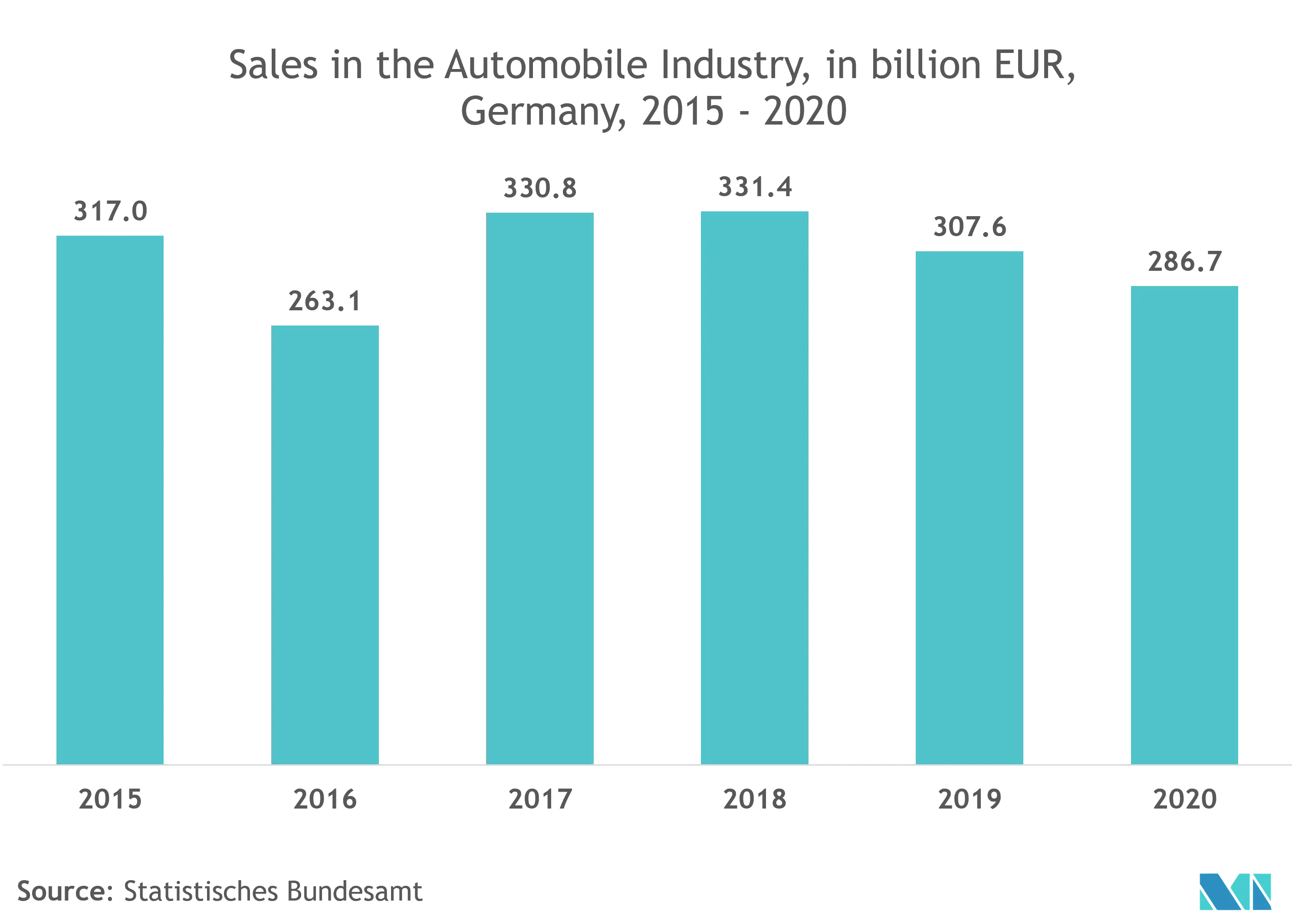
United Kingdom Accounts for the Largest Market Share
- Due to the increasing quest for new energy sources, renewable energy developments, government regulations, and rapid technological advancements in the wireless sensors market is growing lucratively across the country. The country provides a vital component in smart grids for remote monitoring of transformers and power lines, where they are put into service to monitor line temperature and weather conditions.
- In recent years, Sensemetrics Inc., an industrial IoT (IIoT) company, announced that it is launching its IIoT platform in the country. The initial commercial deployment of the sense metrics platform in the U.K. with 3S'TECH, an innovative structural sensing technology company. 3S'TECH connected wireless LoRa tiltmeter sensors, monitoring the Viladecans Hospital near Barcelona, Spain, to the sense metrics platform.
- Furthermore, EU research project WSAN4CIP demonstrated a cost-effective solution for protecting electricity and water networks. The European research project, WSAN4CIP, successfully demonstrated a wireless sensor-based solution for the cost-effective monitoring of electricity distribution networks and water networks. The WSAN4CIP solution was based on a secure communication network of wireless sensors. Since February 2010, it has been successfully implemented and tested in two use cases, one in the energy sector and one in the water utility sector.
- The country's market for Internet of Things (IoT) solutions is significantly growing, driven by solid growth in western and northern European regions. Both consumer and business IoT solutions offer promising opportunities in the area, which is expected to give the European wireless sensors market competitive advantage.
- In May 2021, Advantech has launched a certified wireless module for sensor-to-cloud connectivity for the Internet of Things (IoT) in a compact industry-standard form factor with no programming required. The IoT wireless sensor applications include cold chain/refrigerator monitoring, smart waste management, asset tracking, smart agriculture, and smart street lighting.
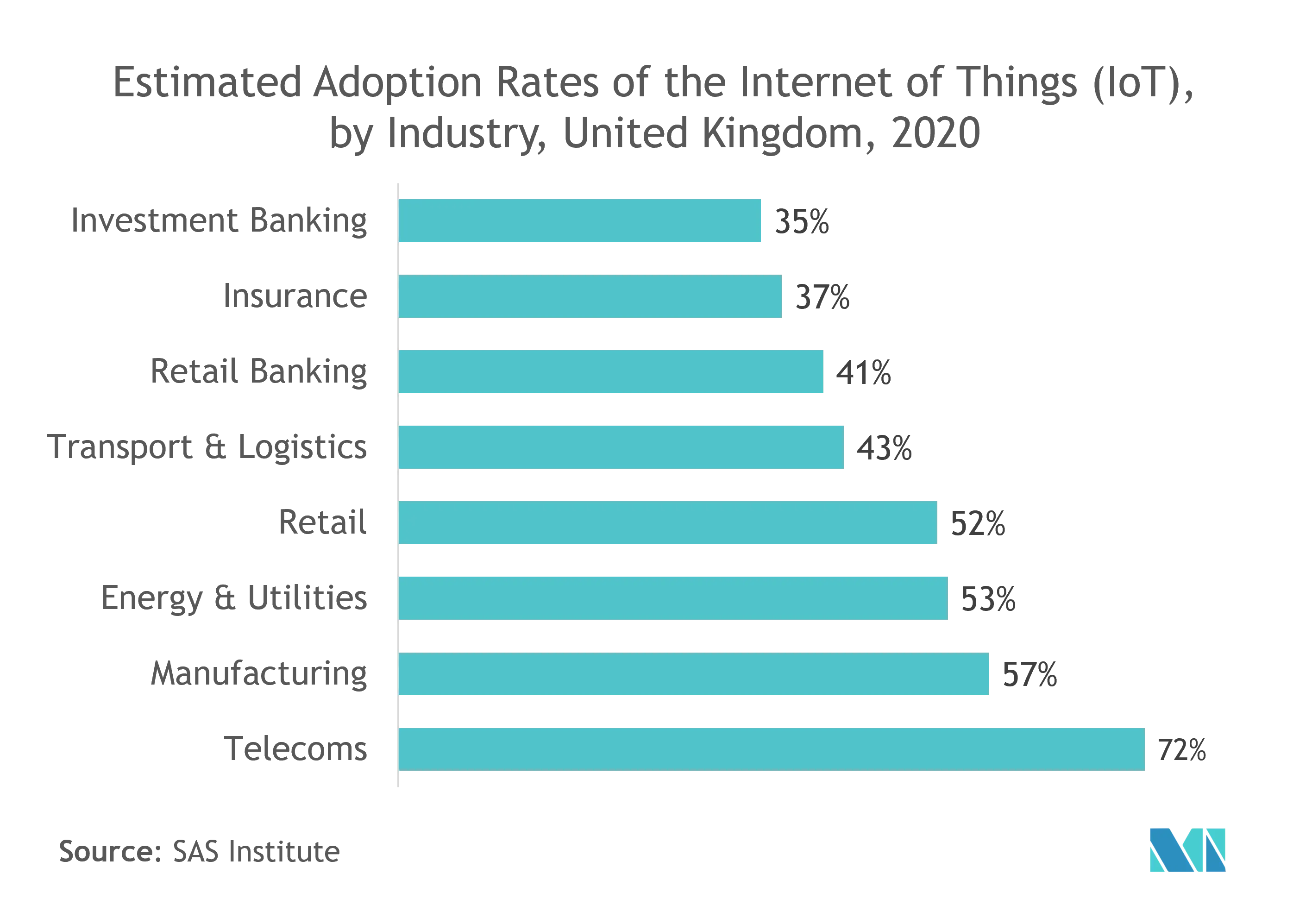
Europe Wireless Sensors Industry Overview
The European wireless sensor is highly competitive owing to multiple vendors providing wireless sensors to the domestic and international markets. The market appears to be moderately fragmented, and the major players with a prominent share in the market are focusing on expanding their customer base across international countries. Additionally, these companies are continuously innovating their products to increase their market share and increase their profitability. Some of the recent developments in the market are:
- January 2021 - Everactive, a technology company that builds the Internet of Things (IoT) solutions, raised USD 35 million in funding to develop its battery-free wireless sensors. The funds will be used to accelerate sales, marketing, and product development of the company's battery-free wireless sensors for industrial applications. Moreover, Everactive's end-to-end monitoring solutions are aimed at high-volume industrial assets that are currently unmonitored or under-monitored due to sheer volume.
- November 2020 - Universität Würzburg developed a sensor film to monitor how an aircraft and spacecraft withstand the mechanical stresses of flight. The film uses tomographic measuring methods that are not yet common in aerospace. The film functions as a circuit carrier for a wireless sensor network and can also be attached to hard-to-reach places on aircraft and spacecraft, making it flexible.
Europe Wireless Sensors Market Leaders
-
Honeywell International Inc.
-
Emerson Electric Co.
-
Schneider Electric
-
Siemens AG
-
ABB Ltd.
*Disclaimer: Major Players sorted in no particular order
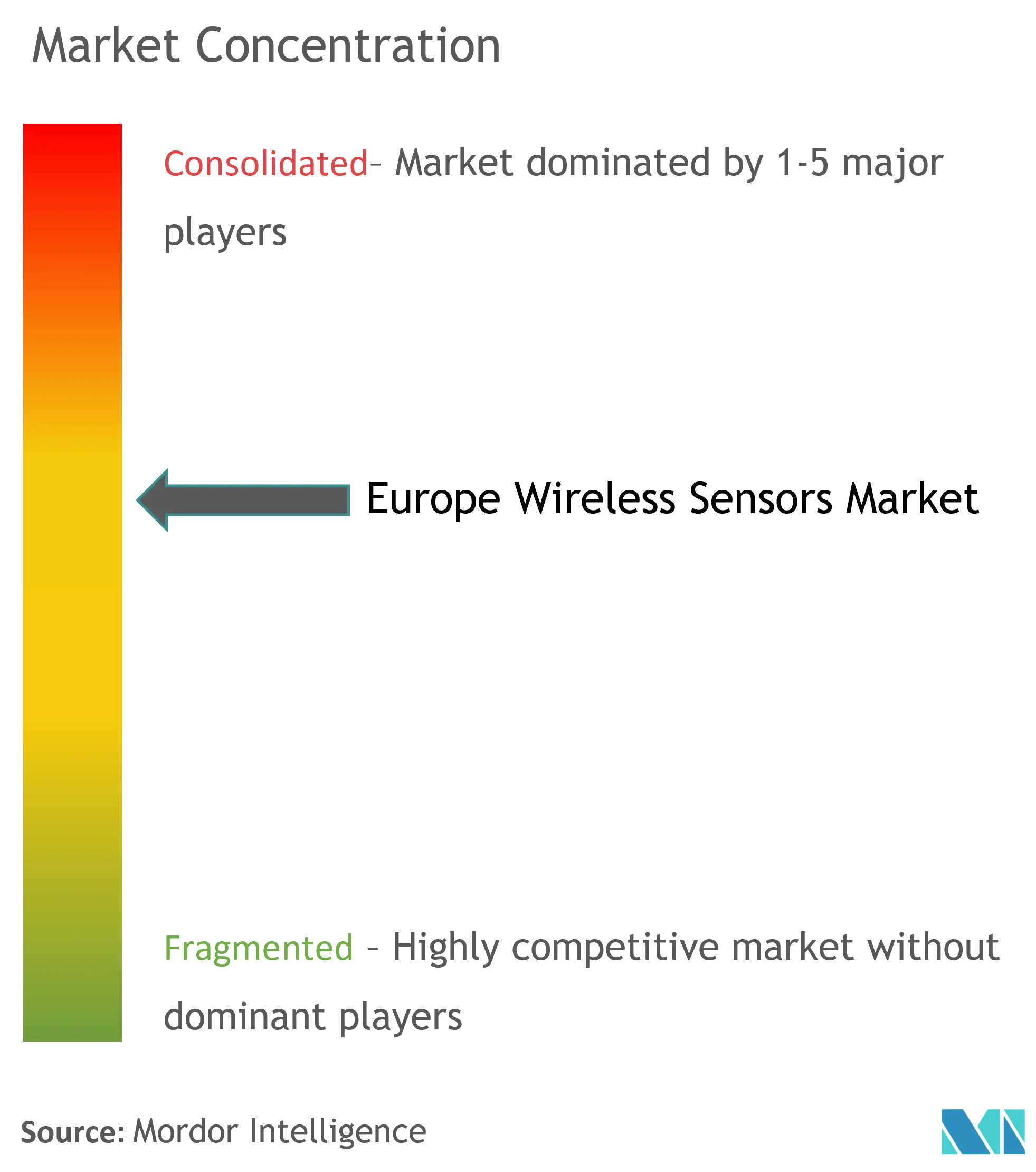
Europe Wireless Sensors Market News
- January 2021 - Disruptive Technologies (DT), a Norwegian developer smallest wireless sensors, collaborated with Ex-tech Group, an expert in the ex-area. Sensors from Disruptive Technologies have an IP68 rating and can withstand extremely high temperatures. Moreover, sensors can measure critical humidity, temperature, and proximity/presence in explosive atmospheres. Owing to the ex-protection, they can be deployed directly on/in other Ex-protected equipment. The sensor solution provides accurate monitoring and reporting of operational data continuously.
- June 2020 - ABB announced a wireless condition monitoring solution for rotating equipment on an industrial scale. The use of wireless sensors reduces the expense and complexity of sensor installation, wiring, and connection. Customers with large sites, such as automotive manufacturing plants, processing plants, or airport baggage handling systems, can now collect valuable health and performance data from rotating equipment using ABB ability smart sensor technology and Aruba Wi-Fi infrastructure.
Europe Wireless Sensors Market Report - Table of Contents
1. INTRODUCTION
- 1.1 Study Assumptions and Market Definition
- 1.2 Scope of the Study
2. RESEARCH METHODOLOGY
3. EXECUTIVE SUMMARY
4. MARKET INSIGHTS
- 4.1 Market Overview
- 4.2 Industry Value Chain Analysis
-
4.3 Industry Attractiveness - Porter's Five Forces Analysis
- 4.3.1 Bargaining Power of Suppliers
- 4.3.2 Bargaining Power of Consumers
- 4.3.3 Threat of New Entrants
- 4.3.4 Threat of Substitutes
- 4.3.5 Intensity of Competitive Rivalry
- 4.4 Technology Snapshot
- 4.5 Assessment of the Impact of COVID-19 on the market
5. MARKET DYNAMICS
-
5.1 Market Drivers
- 5.1.1 Increasing Adoption of Wireless Technologies (Especially in Harsh Environments)
- 5.1.2 Emergence of Smart Factory Concepts (Industrial Automation)
-
5.2 Market Challenges
- 5.2.1 Higher Security Needs and Cost associated with the Sensor Products
- 5.2.2 Concerns pertaining to cybersecurity in the IoT space and recent developments
6. MARKET SEGMENTATION
-
6.1 By Type
- 6.1.1 Pressure Sensor
- 6.1.2 Temperature Sensor
- 6.1.3 Chemical and Gas Sensor
- 6.1.4 Position and Proximity Sensor
- 6.1.5 Other Types
-
6.2 By End-user Industry
- 6.2.1 Automotive
- 6.2.2 Healthcare
- 6.2.3 Aerospace and Defense
- 6.2.4 Energy and Power
- 6.2.5 Food and Beverage
- 6.2.6 Other End-user Industries
-
6.3 By Country
- 6.3.1 United Kingdom
- 6.3.2 Germany
- 6.3.3 Italy
- 6.3.4 France
- 6.3.5 Rest of the Europe
7. COMPETITIVE LANDSCAPE
-
7.1 Company Profiles
- 7.1.1 Honeywell International Inc.
- 7.1.2 Emerson Electric Co.
- 7.1.3 Schneider Electric
- 7.1.4 Siemens AG
- 7.1.5 ABB Ltd.
- 7.1.6 Pasco Scientific
- 7.1.7 Monnit Corporation
- 7.1.8 Phoenix Sensors LLC
- 7.1.9 Texas Instruments Incorporated
- *List Not Exhaustive
8. INVESTMENT ANALYSIS
9. FUTURE OUTLOOK OF THE MARKET
** Subject To AvailablityEurope Wireless Sensors Industry Segmentation
The study characterizes the wireless sensors market based on the type of wireless sensors, the end-user industry, and the country. Wireless sensors are measurement tools for monitoring and recording the physical conditions of the environment. They are equipped with transmitters that convert signals from process control instruments into a radio transmission. These sensors have various applications in numerous sectors, such as automotive, healthcare, aerospace, etc. These have formed the part of the study in considering the end-user industry estimation. The scope of the study is currently focused on key regions, such as the United Kingdom, France, Germany, etc. Further, to arrive at the overall market projections, the study analyzes the impact of COVID-19 and the investment scenario and other macro-economic factors.
| By Type | Pressure Sensor |
| Temperature Sensor | |
| Chemical and Gas Sensor | |
| Position and Proximity Sensor | |
| Other Types | |
| By End-user Industry | Automotive |
| Healthcare | |
| Aerospace and Defense | |
| Energy and Power | |
| Food and Beverage | |
| Other End-user Industries | |
| By Country | United Kingdom |
| Germany | |
| Italy | |
| France | |
| Rest of the Europe |
Europe Wireless Sensors Market Research FAQs
What is the current Europe Wireless Sensors Market size?
The Europe Wireless Sensors Market is projected to register a CAGR of 23.10% during the forecast period (2024-2029)
Who are the key players in Europe Wireless Sensors Market?
Honeywell International Inc., Emerson Electric Co., Schneider Electric, Siemens AG and ABB Ltd. are the major companies operating in the Europe Wireless Sensors Market.
What years does this Europe Wireless Sensors Market cover?
The report covers the Europe Wireless Sensors Market historical market size for years: 2019, 2020, 2021, 2022 and 2023. The report also forecasts the Europe Wireless Sensors Market size for years: 2024, 2025, 2026, 2027, 2028 and 2029.
Europe Wireless Sensor Industry Report
Statistics for the 2023 Europe Wireless Sensor market share, size and revenue growth rate, created by Mordor Intelligence™ Industry Reports. Europe Wireless Sensor analysis includes a market forecast outlook to 2029 and historical overview. Get a sample of this industry analysis as a free report PDF download.



